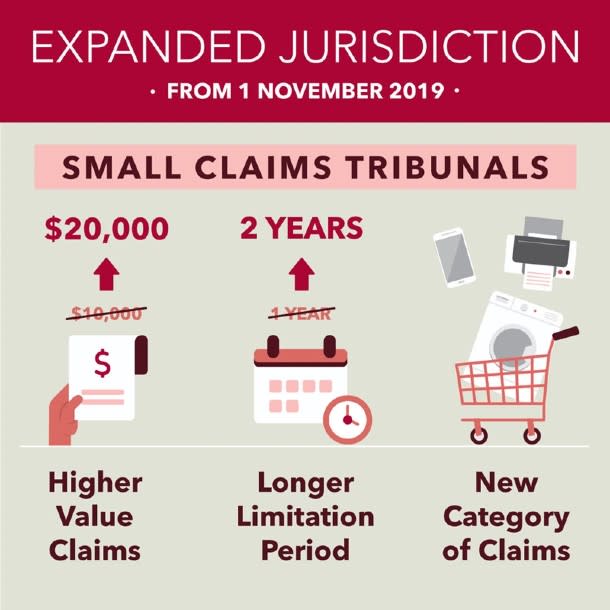How Small Claims Tribunals Can Help Settle Rental Disputes in Singapore (2024)

Small Claims Tribunals are a way landlords and tenants can settle rental disputes sans hefty legal fees. Rental disputes, although not frequent, can sometimes happen between a landlord and tenant.
In line with more rental properties being leased out over the course of the pandemic, the Small Claims Tribunals (SCT) saw 1,510 claims in 2023, up from 930 cases in 2019. These rental spats could happen due to various disagreements over the terms of the tenancy agreement, or things that weren’t covered by it.
In this guide, we’ll walk you through the procedure for filing a claim with the SCT, the filing fees, and key things to take note of. If you’re a tenant who wants to find a different rental property after resolving your rental dispute, let us help.
Small Claims Tribunals: an Overview
What is it? | The SCT’s objective is to resolve minor claims between two parties quickly at an affordable cost |
How to file? | You can submit a claim online through the Community Justice and Tribunals System (CJTS) |
How much does it cost? | To file a claim for $10,000, you’ll only need to pay a fee of $10 to $20. For claims for $30,000, the filing fee can reach up to $300. |
You can read the full guide to small claims, but here’s what you need to know.
What Are the Small Claims Tribunals?
The SCT forms part of the State Courts of Singapore. Established in February 1985, its objective is to quickly resolve minor claims between two parties at an affordable cost. This includes rental disputes between tenants and landlords. Here are some typical rental disputes that the SCT can help resolve:
The landlord seeking damages to amenities and appliances, as well as to the property itself
The tenant asking the landlord to fix appliances or part of the property
Early termination of the tenancy agreement by the landlord or tenant
Forfeiture of the tenant’s security deposit at the end of the lease
Eviction of tenant
However, before seeking the assistance of the SCT, you should first try to settle the rental dispute amicably with the other party. As a tenant or landlord, you can also request that the property agent(s) involved in the rental deal (if applicable) help settle the dispute.

Claim limit: Up to $20,000, and it can also go up to $30,000 if both parties are willing (a Memorandum of Consent must be signed by both parties).
Limitation period: The duration to make a claim is 2 years. This gives you and the other party more time to settle your disputes amicably and file the claim if needed.
Unfair Practice Hire-Purchase Claims: Claims under a hire-purchase agreement (payment through instalments) can be heard.
Powers to Direct Parties to Attend Mediation: The registrar or tribunal can order parties to attend mandatory mediation at the Community Mediation Centre or before anyone.
Powers of the District Court to Send SCT Cases for Rehearing: Under certain circumstances, a district court can send a case back to the tribunal for reconsideration or order a rehearing by a different tribunal.
Additional Reliefs: The SCT may order a tenant who has not paid rent, apart from the outstanding rent, to vacate the property.
Key Rules to Note Before Filing a Claim at the Small Claims Tribunals
Before you lodge a claim, keep the following rules in mind:
You and the respondent must have entered into a valid tenancy agreement
The tenancy agreement signed must be for a residential space only and not for commercial purposes
The tenancy period must not exceed two years
Both you and the respondent must not be bankrupt or insolvent. You may check for this via the Ministry of Law’s Insolvency Office
What Kind of Damages Can Landlords Claim Through the Small Claims Tribunals?
As a landlord, you won’t be able to claim damages caused by wear and tear, especially if the tenancy agreement has the Fair Wear and Tear clause. For example, if the main door has scratches, you won’t be able to ask your tenant to provide compensation to replace it.
Under this clause, it’s acceptable that the items in the property are not in the same condition as at the start of the tenancy period. However, if reckless acts cause the damages and you and your tenant cannot agree to cover the damages, you can file a claim.
You should take photos of the property, including furniture and fixtures, at relevant points of the tenancy period. Should a dispute arise, these pictures can be used as evidence to prove your case.
Types of Disputes You Can File under the Small Claims Tribunals as a Tenant or a Landlord
Below are the disputes that are commonly found between tenants and landlords. For the full list, you may find it here.
Purchase of goods
Provision of services
Damage to property
Disputes over the tenancy lease of residential property not exceeding 2 years
If you are unsure if your claim is within the jurisdiction of the Tribunals, you can take a pre-filling assessment here.
How to File a Small Claim?
Step 1: Log in to submit a claim online through the Community Justice and Tribunals System (CJTS). Select the claim form. Fill in the required information and pay the filing fees. You can pay via credit card, internet banking, or at the State Courts.
Step 2: Choose a consultation date and time once the filing fees are paid. Save and print a copy of the claim and Notice of Consultation to serve the claim. You can read an in-depth guide on accessing the system and filing a small claim here.
Step 3: Within seven days of filing the claim, serve the claim and Notice of Consultation. You must personally deliver or send them via registered post. As the claimant, you are responsible for serving the other party (respondent) a hard copy of the claim and the Notice of Consultation. This is to inform them about the court proceedings and that they need to attend the sessions.
A claim must be served from within Singapore. If you cannot serve the Notice of Consultation, proceed to attend the consultation.
Step 4: Before the first consultation and after serving the claim, upload the Declaration of Service in the CJTS portal. Include the date and time when the Notice of Consultation was served, details of the individual or entity receiving the notice, how they received it, and the outcome of the notice’s service.
At this step, you also want to submit the supporting documents supporting your claim (e.g. receipts, invoices, contracts) under the ‘Online Applications’ tab in the CJTS portal. If the documents are not in English, you must get them translated. A Letter of Authorisation and ACRA Business Profile will be needed for business entities.
How Much Will I Need to Pay to File a Claim?
Claim amount | Individual | Entity |
Up to $5,000 | $10 | $50 |
Between $5,000 and $10,000 | $20 | $100 |
More than $10,000 and up to $20,000 | 1% of the claim amount | 3% of the claim amount |
More than $20,000, up to $30,000 | 1% of the claim amount | 3% of the claim amount |
Do take note that the filing fees are not refundable. Nonetheless, filing a small claim is significantly more affordable than filing a lawsuit with a regular court. Plus, you don’t have to hire a lawyer.
What’s next after Filing the Claim and Serving the Notice to the Respondent?
After filing the claim and serving the notice, you and the respondent must attend a consultation session, where the tribunal will attempt to mediate amicably. During the Consultation, the Registrar will:
Assess if the claim is within the Tribunal’s jurisdiction
Allow both parties to discuss your cases to resolve your dispute amicably
Fix for a Hearing before a Tribunal Magistrate when both parties cannot reach an agreement or make such other orders as it deems fit
If the dispute is not resolved during the Consultation, the SCT can schedule a Hearing within 24 hours of the Consultation session. At the Hearing, both you and the respondent will present your case before the Tribunal Magistrate.
Even after filing the claim, you and the respondent may still attempt to settle your dispute among yourselves. If you reach an agreement before the consultation date, you can withdraw the claim on the CJTS portal.
For more property news, content and resources, check out PropertyGuru’s guides section.
Looking for a new home? Head to PropertyGuru to browse the top properties for sale in Singapore.
Need help to finance your latest property purchase? Let the mortgage experts at PropertyGuru Finance help you find the best deals.



